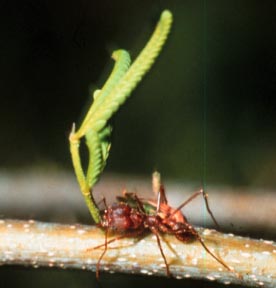Anyone who lives in South or East Texas where deep sandy or sandy loam soils exist knows about leaf cutter ants (Atta texana). Sometimes called cut ants or parasol ants, leaf cutter ants strip the leaves from plants and vegetables including roses, crepe myrtles, hawthorns, fruit trees, beans, squash and pine trees. They work quickly and steadily at night, carrying bits of leaves back to their nests where they farm the vegetation to produce the fungi on which they feed.
According to Molly Keck, IPM Program Specialist with Texas A&M AgriLife Extension Service in Bexar County, leaf cutter ants can be difficult to manage. Although you may never eliminate the colony, you can get them under control.
Here are some tips to help slow them down:
- Do a flashlight survey of your landscape at night if you suspect they are stripping the leaves from your plants. This will allow you to find their trails.
- Use Tanglefoot or similar sticky material around the trunk(s) of the shrubs being stripped to serve as a barrier to keep the ants from reaching the leaves. It has to be reapplied occasionally, especially if the ants are present.
- For more aggressive suppression, follow the ant trails across the surface until you find where they are going down into the ground. Apply one teaspoon of a dust insecticide around the entrance hole to suppress their activities for a few days and allow the plants to recover.
- Consider using a low-toxicity bait product specifically labeled for leaf cutter ants. Apply bait along the trails while the ants are actively carrying plant materials back to the nest. This may suppress activity for 4-6 weeks.
There are no bait products that will eliminate a leaf cutter ant colony, but we can slow down the Texas leaf cutter ant defoliations with constant vigilance.





